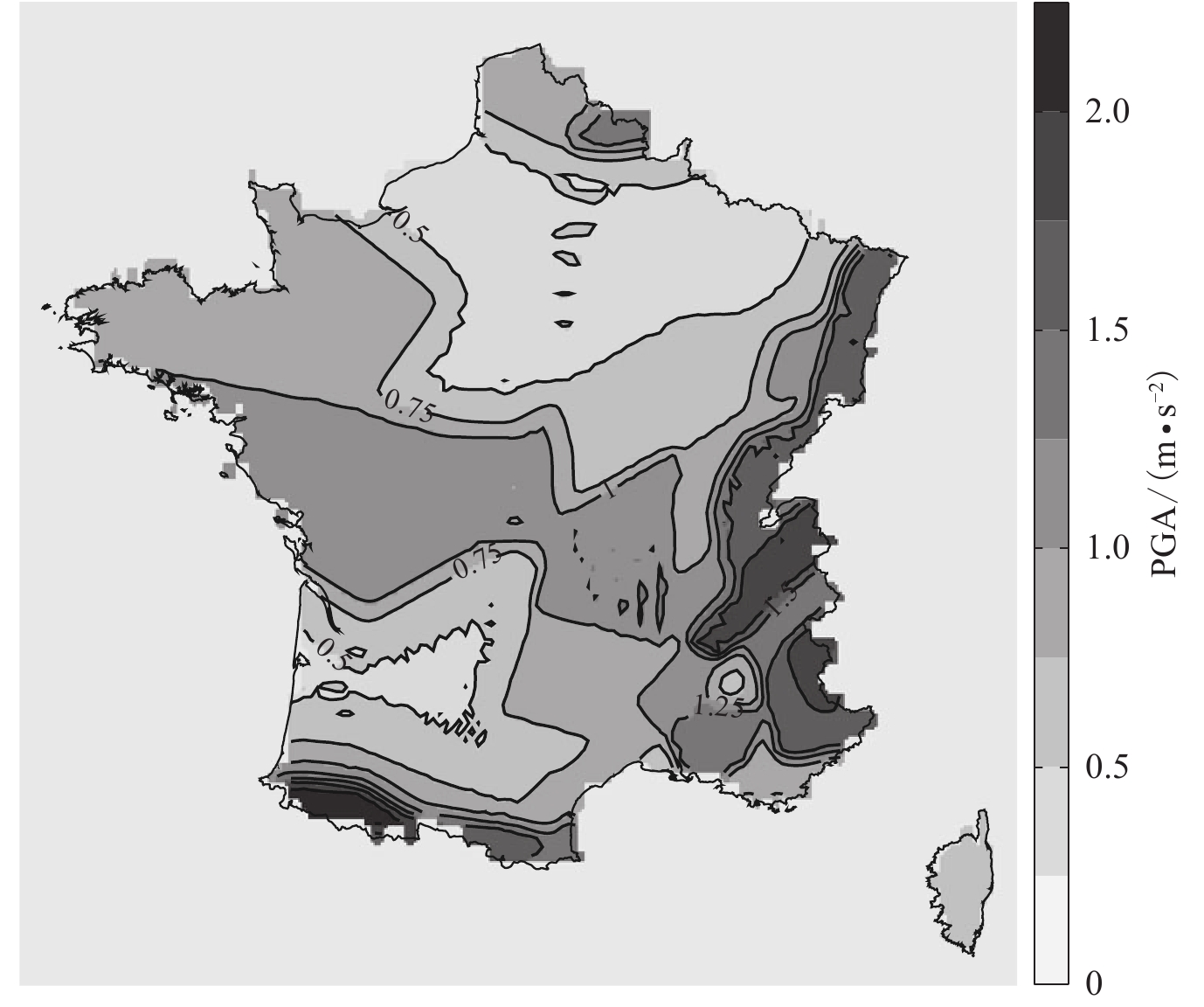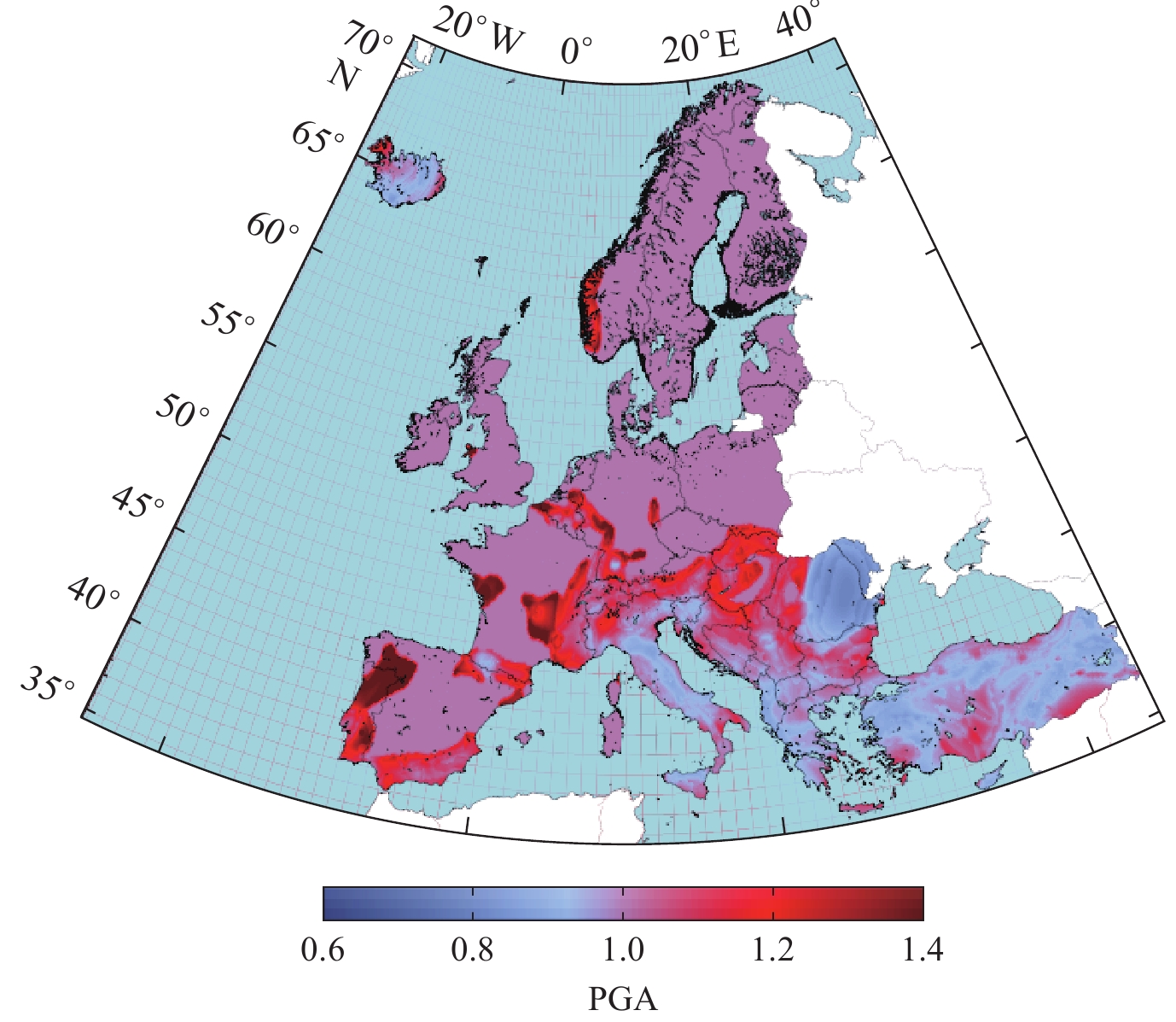Risk-targeted seismic zoning maps
-
摘要: 为保证国土范围内建筑倒塌风险的一致性,提出了基于目标风险的地震区划图。该图通过求取地震危险性曲线与结构易损性曲线的卷积的风险积分方法计算目标风险。本文介绍了采用风险积分法确定基于目标风险的地震动参数的基本原理,回顾了这项技术在国内外研究与应用的最新进展。此外,还讨论了基于目标风险的地震区划图未来的发展及可能面临的问题。Abstract: To ensure the consistency of building collapse risk within the country, a risk-targeted seismic zoning map is proposed. The risk integral method calculates the target risk by the convolution of the seismic hazard curve and the structural vulnerability curve. Currently, the use of risk-targeted seismic zoning maps has been widely used in practice in the United States, and related studies have been conducted in France, Romania, Canada, Indonesia, Europe and China. This article introduces the basic principles of using the risk integral method to determine the risk-targeted ground motion parameters and reviews the recent progress of research and application of this technique in China and abroad. In addition, we discuss the future development of risk-targeted seismic zoning maps and some of the problems may face.
-
Keywords:
- risk integral /
- risk-targeted /
- acceptable risk /
- seismic zoning map /
- seismic design map
-
-
图 2 法国大陆基于目标风险的PGA抗震设计图(引自Douglas et al,2013)
Figure 2. Seismic design map of risk-targeted PGA in France (after Douglas et al,2013)
图 3 欧洲大陆基于目标风险的PGA风险系数图(引自Silva et al,2016)
Figure 3. Risk coefficients map of risk-targeted PGA in Europe (after Silva et al,2016)
-
潘华,张萌,李金臣. 2017. 美国地震区划图的发展:地震危险性图与抗震设计图[J]. 震灾防御技术,12(3):511–522. Pan H,Zhang M,Li J C. 2017. Review of seismic zonation in United States,seismic hazard maps and seismic design maps[J]. Technology for Earthquake Disaster Prevention,12(3):511–522 (in Chinese).
王丛,吕大刚. 2020. 基于抗震规范和地震动区划图的风险导向地震动决策参数分析[J]. 建筑结构学报,41(8):19–28. doi: 10.14006/j.jzjgxb.2018.0703 Wang C,Lü D G. 2020. Analysis of risk-targeted decision parameters of seismic ground motions based on seismic design code and ground motion zonation map of China[J]. Journal of Building Structures,41(8):19–28 (in Chinese).
张萌. 2021. 基于风险的地震动确定[D]. 北京: 中国地震局地球物理研究所: 45–48. Zhang M. 2021. Risk-Targeted Ground Motion and Its Application[D]. Beijing: Institute of Geophysics, China Earthquake Administration: 45–48 (in Chinese).
张萌, 潘华. 2022. 中国大陆地区建筑结构一致倒塌风险的设计地震动研究[J/OL]. 建筑结构学报. doi: 10.14006/j.jzjgxb.2021.0317. Zhang M, Pan H. 2022. Study on design ground motion for uniform collapse risk of building structures in mainland China[J/OL]. Journal of Building Structures. doi: 10.14006/j.jzjgxb.2021.0317 (in Chinese).
张萌,潘华,李金臣. 2017. 美国建筑抗震设计的法规体系与设计地震动的确定[J]. 震灾防御技术,12(2):306–318. doi: 10.11899/zzfy20170207 Zhang M,Pan H,Li J C. 2017. Building anti-seismic design regulations in the United States and its approach to ground motion design[J]. Technology for Earthquake Disaster Prevention,12(2):306–318 (in Chinese).
中华人民共和国国家质量监督检验检疫总局, 中国国家标准化管理委员会. 2016. GB 18306—2015中国地震动参数区划图[S]. 北京: 中国标准出版社: 4. General Administration of Quality Supervision, Inspection and Quarantine of the People’s Republic of China, Standardization Administration of the People’s Republic of China. 2016. GB 18306−2015 Seismic Ground Motion Parameters Zonation Map of China[S]. Beijing: Standards Press of China: 4 (in Chinese).
中华人民共和国住房和城乡建设部, 中华人民共和国国家质量监督检验检疫总局. 2010. GB 50011—2010建筑抗震设计规范[S]. 北京: 中国建筑工业出版社: 18−20. Ministry of Housing and Urban-Rural Development of the People’s Republic of China, General Administration of Quality Supervision, Inspection and Quarantine of the People’s Republic of China. 2010. GB 50011−2010 Code for Seismic Design of Buildings[S]. Beijing: China Architecture & Building Press: 18−20 (in Chinese).
Allen T I, Adams J, Halchuk S. 2015. The seismic hazard model for Canada: Past, present and future[C]//Proceedings of the Tenth Pacific Conference on Earthquake Engineering Building: An Earthquake-Resilient Pacific. Sydney, Australia: Seismology Research Center: 5.
ASCE. 2005. ASCE/SEI 43-05 Seismic Design Criteria for Structures, Systems, and Components In Nuclear Facilities[S]. Reston, Virginia: ASCE: 109−117.
ASCE. 2010. ASCE 7-10 Minimum Design Loads for Buildings and Other Structures[S]. Reston, Virginia: American Society of Civil Engineers: 207−211.
ATC. 1978. Tentative Provisions for the Development of Seismic Regulations for Buildings, Report ATC 3-06[R]. Washington D C: Applied Technology Council, National Bureau of Standards, U.S. Government Printing Office: 296−312.
Douglas J,Ulrich T,Negulescu C. 2013. Risk-targeted seismic design maps for mainland France[J]. Nat Hazards,65(3):1999–2013. doi: 10.1007/s11069-012-0460-6
Federal Emergency Management Agency, 1998. NEHRP Recommended Provisions for Seismic Regulations for New Buildings and Other Structures, Part 1: Provisions[R]. Washington D C: Federal Emergency Management Agency, Building Seismic Safety Council: 10−18.
Federal Emergency Management Agency. 2009. NEHRP Recommended Seismic Provisions for New Buildings and Other Structures: FEMAP-750[R]. Washington D C: Federal Emergency Management Agency: 21−28.
Federal Emergency Management Agency. 2010. Earthquake-Resistant Design Concepts: An Introduction to the NEHRP Recommended Seismic Provisions for New Buildings and Other Structures: FEMAP-749[R]. Washington D C: Federal Emergency Management Agency: 13−20.
Iervolino I, Spillatura A, Bazzurro P. 2017. RINTC project: Assessing the (implicit) seismic risk of code-conforming structures in Italy[C]//6th ECCOMAS Thematic Conference on Computational Methods in Structural Dynamics and Earthquake Engineering. Rhodes, Greece: Institute of Structural Analysis and Antiseismic Research, School of Civil Engineering, National Technical University of Athens (NTUA), Greece: 1545–1557.
Kennedy R P, Short S A. 1994. Basis for Seismic Provisions of DOE-STD-1020[R]. Washington D C: USDOE: 1–4.
Kennedy R P. 2011. Performance-goal based (risk informed) approach for establishing the SSE site specific response spectrum for future nuclear power plants[J]. Nucl Eng Des,241(3):648–656. doi: 10.1016/j.nucengdes.2010.08.001
Kharazian A,Molina S,Galiana-Merino J J,Agea-Medina N. 2021. Risk-targeted hazard maps for Spain[J]. Bull Earthq Eng,19(13):5369–5389. doi: 10.1007/s10518-021-01189-8
Liel A B, Luco N, Raghunandan M, Champion C P. 2015. Modifications to risk-targeted seismic design maps for subduction and near-fault hazards[C]//12th International Conference on Applications of Statistics and Probability in Civil Engineering. Vancouver, Canada: Civil Engineering Risk and Reliability Association: 1–8.
Luco N, Ellingwood B R, Hamburger R O, Hooper J D, Kimball J K, Kircher C A. 2007. Risk-targeted versus current seismic design maps for the conterminous United States[C]//SEAOC 2007 Convention Proceedings. California: Structural Engineers Association of California: 1–7.
McGuire R K. 2004. Seismic Hazard and Risk Analysis[M]. Oakland, CA: Earthquake Engineering Research Institute: 143–153.
Sengara I W,Sidi I D,Mulia A,Asrurifak M,Hutabarat D. 2016. Development of risk coefficient for input to new Indonesian seismic building codes[J]. J Eng Technol Sci,48(1):49–65. doi: 10.5614/j.eng.technol.sci.2016.48.1.5
Sengara I W, Irsyam M, Sidi I D, Mulia A, Asrurifak M, Hutabarat D, Partono W. 2020. New 2019 risk-targeted ground motions for spectral design criteria in Indonesian seismic building code[C/OL]. E3S Web Conf, 156(1): 03010.
Silva V,Crowley H,Bazzurro P. 2016. Exploring risk-targeted hazard maps for Europe[J]. Earthq Spectra,32(2):1165–1186. doi: 10.1193/112514eqs198m
Taherian A R,Kalantari A. 2019. Risk-targeted seismic design maps for Iran[J]. J Seismol,23:1299.
Taherian A R,Kalantari A. 2021. Analysis of the risk-targeting approach to defining ground motion for seismic design:A case study of Iran[J]. Bull Earthq Eng,19(3):1289–1309. doi: 10.1007/s10518-020-01023-7
USNRC. 2007. A Performance-Based Approach to Define the Site-Specific Earthquake Ground Motion[S]. Washington D C: USNRC: 17–18.
Vacareanu R,Pavel F,Craciun I,Coliba V,Arion C,Aldea A,Neagu C. 2018. Risk-targeted maps for Romania[J]. J Seismol,22(2):407–417. doi: 10.1007/s10950-017-9713-x
-
期刊类型引用(49)
1. 李鸿儒,李夕海,牛超,张云,刘继昊,谭笑枫. 基于GA-XGBoost的天然地震与爆破的小样本分类. 地震学报. 2025(02): 221-231 .  本站查看
本站查看
2. 杨祖鉴,田宵,陈奕冲,甘兆龙,刘安福,裴重茂,张中将. 基于迁移学习的天然地震和爆破事件识别在美国加州和犹他州的应用. 工程地球物理学报. 2025(02): 172-182 .  百度学术
百度学术
3. 刘天龙,田雨佳,王嗣涵,栾天. 矿震信息自动产出系统设计与实现. 防灾减灾学报. 2024(03): 74-78 .  百度学术
百度学术
4. 沈婕,朱景宝,缪发军,宋晋东,李山有. 基于残差神经网络的天然地震与非天然地震信号分类. 地震工程与工程振动. 2024(05): 13-25 .  百度学术
百度学术
5. 曾晓燕,邱强,蒋策,周少辉,梁明,熊成. 基于卷积神经网络的地震与爆破识别模型及其在广东地区的初步应用. 地震学报. 2024(06): 1002-1013 .  本站查看
本站查看
6. 张帆,杨晓忠,王树波. 基于LSTM神经网络的地震事件分类. 计算机应用与软件. 2023(04): 75-79 .  百度学术
百度学术
7. 张玲,李丽. 2021年8月11日山西云冈M_L 3.0地震事件类型研究. 地震地磁观测与研究. 2023(03): 27-33 .  百度学术
百度学术
8. 徐玉聪,朱建,董建辉,周鲁. 三峡库区仙女山断裂周缘地震类型特征识别. 水利水电快报. 2022(02): 9-16 .  百度学术
百度学术
9. 张娜,王霞. 基于S变换的山西地区不同地震事件频谱特征分析. 山西地震. 2022(01): 1-6+11 .  百度学术
百度学术
10. 郑亚迪,宋美卿. 山西大同、朔州地区非天然地震特征与识别. 山西地震. 2022(01): 7-11 .  百度学术
百度学术
11. 邵永谦,王国成,彭钊,于海英,王鹏,王成睿. 基于标准时频变换的上海地区地震与爆破识别. 华北地震科学. 2022(02): 48-55 .  百度学术
百度学术
12. 田宵,汪明军,张雄,王向腾,盛书中,吕坚. 基于多输入卷积神经网络的天然地震和爆破事件识别. 地球物理学报. 2022(05): 1802-1812 .  百度学术
百度学术
13. 吴涛,庞聪,江勇,丁炜,廖成旺. 基于随机子空间和Ada Boost集成学习的地震事件性质辨识研究. 地球物理学进展. 2022(03): 981-988 .  百度学术
百度学术
14. 庞聪,丁炜,程诚,吴涛,江勇,马武刚,廖成旺. 粒子群优化广义回归神经网络与HHT样本熵结合的地震辨识研究. 地球物理学进展. 2022(04): 1457-1463 .  百度学术
百度学术
15. 庞聪,江勇,廖成旺,吴涛,丁炜. 基于MFCC样本熵和灰狼算法优化支持向量机的天然地震与人工爆破自动识别. 地震工程学报. 2022(05): 1169-1175 .  百度学术
百度学术
16. 胡琪鑫,徐亚. 地球物理信号特征识别与解释的机器学习方法及应用综述. 地球物理学进展. 2022(06): 2395-2407 .  百度学术
百度学术
17. 施佳朋,黄汉明,薛思敏,黎炳君,袁雪梅. 基于EMD-VMD-LSTM的地震信号分类研究. 传感器与微系统. 2021(06): 57-59+62 .  百度学术
百度学术
18. 蔡杏辉,廖诗荣,张燕明,陈惠芳,林彬华. 基于支持向量机的地震事件类型自动识别及应用. 华南地震. 2021(02): 27-35 .  百度学术
百度学术
19. 周少辉,蒋海昆,李健,曲均浩,郑晨晨,李亚军,张志慧,郭宗斌. 基于深度学习的地震事件分类识别——以山东地震台网记录为例. 地震地质. 2021(03): 663-676 .  百度学术
百度学术
20. 施佳朋,黄汉明,薛思敏,黎炳君. 基于PSO-SVM的地震信号分类识别研究. 计算机与数字工程. 2021(06): 1037-1041+1046 .  百度学术
百度学术
21. 段刚. 基于卷积神经网络的天然地震与人工爆破识别研究. 地球物理学进展. 2021(04): 1379-1385 .  百度学术
百度学术
22. 张帆,杨晓忠,吴立飞,韩晓明,王树波. 基于短时傅里叶变换和卷积神经网络的地震事件分类. 地震学报. 2021(04): 463-473+533 .  本站查看
本站查看
23. 蔡杏辉,张燕明,陈惠芳,巫立华. 基于小波特征和神经网络的天然地震与人工爆破自动识别. 大地测量与地球动力学. 2020(06): 634-639 .  百度学术
百度学术
24. 毛世榕,史水平,苏梅艳,蒋志峰,玉壮基. 基于RBF神经网络的地震与爆破识别技术. 地震地磁观测与研究. 2020(03): 59-66 .  百度学术
百度学术
25. 高家乙,刘晓锋,闫睿. 河南平顶山平煤矿区天然地震、爆破、塌陷时频特征分析. 地震地磁观测与研究. 2020(03): 67-74 .  百度学术
百度学术
26. 范晓易,曲均浩,刘方斌,周少辉. 使用支持向量机识别地震类型的影响因素分析. 大地测量与地球动力学. 2020(10): 1034-1038 .  百度学术
百度学术
27. 徐岩,张珂,倪铭,王勇,郝美仙. 内蒙古地区非天然地震的特征与识别. 地震地磁观测与研究. 2020(04): 42-48 .  百度学术
百度学术
28. 张媛媛,王婷婷,苏丽娜,杨宜海,惠少兴. 陕北塌陷记录的区域特征研究. 地震学报. 2020(06): 684-696+781 .  本站查看
本站查看
29. 任涛,林梦楠,陈宏峰,王冉冉,李松威,刘晓雨,刘杰. 基于Bagging集成学习算法的地震事件性质识别分类. 地球物理学报. 2019(01): 383-392 .  百度学术
百度学术
30. 包宝小,贾宝金,刘芳,席文雅. 乌兰浩特地震台爆破与地震记录识别判据. 地震地磁观测与研究. 2019(03): 40-46 .  百度学术
百度学术
31. 范晓易,曲均浩,曲保安,刘方斌,山长仑,周少辉. 支持向量分类机LIBSVM方法识别天然地震、爆破与塌陷. 大地测量与地球动力学. 2019(09): 916-918 .  百度学术
百度学术
32. 陈润航,黄汉明,施佳朋,薛思敏,袁雪梅. 天然地震与人工爆破地震波形的实时分类研究. 地球物理学进展. 2019(05): 1721-1727 .  百度学术
百度学术
33. 张诺男,高国明,徐丹,张晓宇,肖雯静. 利用LS-SVM对天然地震与人工爆破识别研究. 电脑知识与技术. 2018(09): 226-228+241 .  百度学术
百度学术
34. 陈润航,黄汉明,柴慧敏. 地震和爆破事件源波形信号的卷积神经网络分类研究. 地球物理学进展. 2018(04): 1331-1338 .  百度学术
百度学术
35. 周海军,李磊. 地震波形的HHT特征提取和GMM识别研究. 黑龙江工业学院学报(综合版). 2018(04): 69-73 .  百度学术
百度学术
36. 张杏莉,贾瑞生,卢新明,彭延军,赵卫东. 爆破震动与煤岩破裂微震信号辨识研究. Applied Geophysics. 2018(02): 280-289+364 .  百度学术
百度学术
37. 周海军,李磊. 地震波形的希尔伯特黄变换特征提取与隐马尔科夫模型识别研究. 宿州学院学报. 2018(07): 86-89 .  百度学术
百度学术
38. 张红才,金星,李军,陈智勇. P_d-τ_c相容性检验方法在触发事件判别分析中的应用. 地震学报. 2017(01): 102-110 .  本站查看
本站查看
39. 赵刚,黄汉明,卢欣欣,郭世豪,柴慧敏. 基于BP-Adaboost方法的天然地震和人工爆炸事件波形信号分类识别研究. 地震工程学报. 2017(03): 557-563 .  百度学术
百度学术
40. 崔鑫,许力生,许忠淮,李铂,王峰. 小地震与人工爆破记录的时频分析. 地震工程学报. 2016(01): 71-78 .  百度学术
百度学术
41. 牟剑英,韦峰,谢夜玉,龙政强. 南丹大厂矿区人工爆破与天然地震的判定研究. 华南地震. 2015(01): 51-56 .  百度学术
百度学术
42. 周海军,陈银燕. 一种基于LPCC的天然地震和人工爆破识别算法. 滁州学院学报. 2014(02): 80-82 .  百度学术
百度学术
43. 王婷婷,边银菊,张博. 地震与爆破的小波包识别判据研究. 地震学报. 2014(02): 220-232+339 .  本站查看
本站查看
44. 姜福兴,尹永明,朱权洁,李舒霞,于正兴. 单事件多通道微震波形的特征提取与联合识别研究. 煤炭学报. 2014(02): 229-237 .  百度学术
百度学术
45. 王婷婷,边银菊,张博. 地震和爆破的综合识别方法研究. 地球物理学进展. 2013(05): 2433-2443 .  百度学术
百度学术
46. 毕明霞,黄汉明,边银菊,周海军,陈银燕,赵静. 基于经验模态分解的地震波特征提取的研究. 地球物理学进展. 2012(05): 1890-1896 .  百度学术
百度学术
47. 刘莎,杨建思,田宝峰,郑钰,姜旭东,徐志强. 首都圈地区爆破、矿塌和天然地震的识别研究. 地震学报. 2012(02): 202-214+282 .  本站查看
本站查看
48. 李希亮,李栋梁,张玲,董晓娜,吴丹桐,李霞,金鹏,赵小贺. 支持向量机方法在地球物理学中的应用与展望. 华南地震. 2012(04): 52-58 .  百度学术
百度学术
49. 毕明霞,黄汉明,边银菊,李锐,陈银燕,赵静. 天然地震与人工爆破波形信号HHT特征提取和SVM识别研究. 地球物理学进展. 2011(04): 1157-1164 .  百度学术
百度学术
其他类型引用(27)





 下载:
下载:


